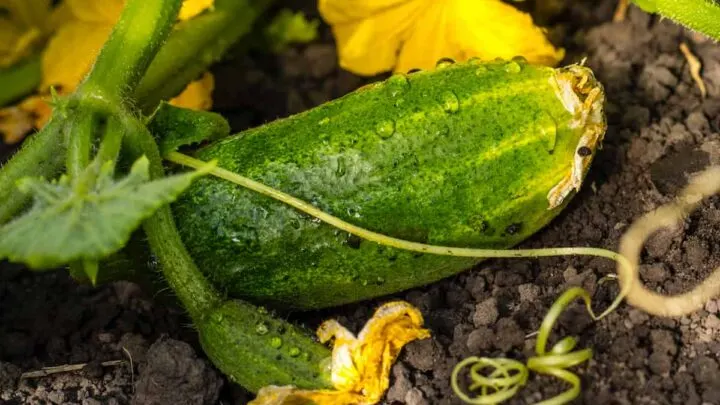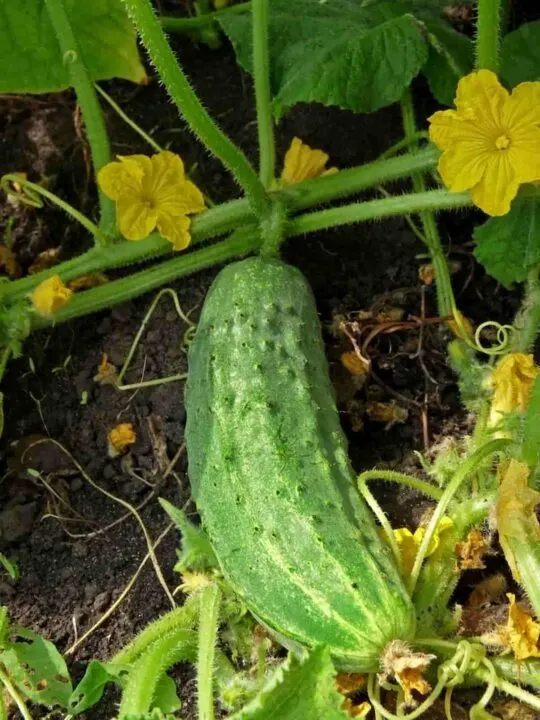Cucumbers grow quickly, and it is quite gratifying to witness their vines branch out, lengthen, and climb as they mature. Cucumber vines are hearty and strong to bear the weight of their extended, bountiful summer harvest. These vines also aid in transporting water and nutrients throughout the plant. It can be devastating for the plant to damage its vines, especially if the harm persists. Some gardeners may be wondering, why are my cucumber vines splitting?
Most commonly, cucumber vines splitting is due to cold damage. However, vine splitting can also be caused by rapid growth resulting from increased temperature, hydration, or nutrition. Less commonly, stem splitting can be caused by extreme winds, outside animals (wild or domestic), or the peskiest of pests, the squash vine borer.
Read on to learn more about maintaining the health of your cucumber plants.

Causes & Solutions of Cucumber Vine Splitting
This section explores possible causes of cucumber vine splitting as well as methods of prevention, mitigation, and solutions.
Cold Damage
Cold damage is the most common reason a cucumber plant’s vines may split. Cucumbers are warm weather plants and are only viable in the summertime in most growing zones. Growing zones are sectioned by climate norms and can be determined by visiting the USDA plant hardiness zone map. Cucumbers are susceptible to cold and frost.
They thrive in temperatures of 75 – 85 degrees Fahrenheit and may start to show signs of damage if temperatures dip below 50 degrees. Following recommended planting schedules for your growing zone can help to avoid cold temperatures damaging your plant.
Even when following the best practices for your growing zone, it is not unheard of for nature to throw a curveball with unseasonably low temperatures from time to time. If temperatures are expected to drop below 50 degrees, you can still protect your cucumbers from the cold and potential damage. In these situations, if cucumbers are in containers and space allows, you could always move your cucumber plant indoors for a cold spell.
Another option for cucumbers that can’t be moved indoors is to cover plants with a sheet or tarp overnight and uncover them when daytime temperatures warm up. Typically, covering plants creates enough of a barrier between the frost and cold to keep the plant healthy.

Rapid Growth
Rapid growth is most common when a seedling kept in a small container is transplanted into a larger container or garden plot, resulting in more exposure to elements that promote growth. Often transplanting cucumbers leads to the plant being exposed to higher temperatures as the growing season extends into late spring and summer. In addition, transplanting may lead to an increase in moisture and nutrients.
While the temperature increase is inevitable when transplanting cucumbers, the irrigation and fertilizer issues can be controlled with some practice. Depending on your geographic location, spring and summer rain showers may be more or less common.
However, the level of hydration your cucumber plant receives can usually still be controlled by developing practices of consistent, regular irrigation around any rain watering that may occur. If fertilizing your cucumber plants, it’s important to follow the recommended timing and dosage of nutrients to avoid issues with rapid growth.

Extreme Weather
Some growing climates are prone to thunderstorms or even tornadoes with winds that can wreak havoc on a mature cucumber plant’s weighty vines. While we can’t control the weather, if storms are common where you live, you may consider the location of your cucumber plants as well as how you train them to grow. Cucumber vines like to climb but can also spread out across the earth.
Keeping vines low can keep them out of strong winds but could put them at risk of wildlife, as discussed in the next section.
Another way to prevent weather damage is to grow your cucumbers against a structure. Barns, sheds, and even the side of your house can work great for this! Instead of a free-standing trellis system, one can be created against a wall to create more stability and less chance for plant damage.

Outside Animals
Often when gardeners think of common wildlife such as deer or rabbits, we think of them eating the vegetables we’ve worked so hard to grow. However, sometimes the issue with these lovely creatures and pets is that they may trample through our gardens, which can occasionally cause vine splitting in cucumbers.
Creating a trellis system for cucumber vines to grow up and off the earth is a great way to prevent this issue. Another option is to create fencing around your garden plot that keeps these loveable creatures out.
Squash Vine Borer
The squash vine borer is a pest that acts out its name. It is a common moth larva that feeds on the vines of squash and, less frequently, cucumbers by literally boring into the center of the plant’s vine.
These pests are most active from mid-June through July and can quickly take out a squash or cucumber crop. If cucumber vine splitting is noticed due to a squash vine borer, the pest has damaged the plant to no return.
However, carefully observing plants in late spring and early summer for black and orange clearwing moth activity around plants, their eggs, or larvae on the plant and removing them helps mitigate the potential issue. In geographic locations where the squash vine borer is common, gardeners may use row covers to protect the plants.

Resistant Cucumber Varieties
Although cucumbers tend not to be very cold, disease, or pest resistant, some cucumber varieties can handle these adversaries better than others. Check out the following table to explore some resistant cucumber varieties:
| Cucumber Varieties | Resistance / Tolerance |
| Wisconsin | Cold tolerant |
| Thunder | Disease resistant, specifically to powdery and downy mildews. |
| Corinto | Cold tolerant |
| Marketmore 76 | Pest and disease resistant to powdery and downy mildews. |
| Indy | Disease resistant, specifically to powdery and downy mildews. |
| Socrates | Cold tolerant |
| Dasher II | Disease resistant to scab, mosaic virus and mildews. |
Final Tips On Growing Cucumbers
The goal of most gardeners with a cucumber crop is to maintain this annual plant’s health through a lengthy and abundant harvest. Ensuring you are following the recommended outdoor time frame for your growing zone is ideal.
In addition, proper light and temperature as well as appropriate amounts of moisture and nutrients will further benefit the health of your cucumbers. When issues such as plant damage, disease, or pests arise, addressing the concern early and quickly, with the appropriate solution is what will most likely get you to that bountiful harvest.

Hi there, my name is Allie and welcome to my blog; GareningWithAllie!
Much of what you see written here is just our personal experiences with gardening. Along with the content I write here, there is also a unique collection of gardening topics covered by some of our close friends. I hope you find everything you read here to be helpful, informative, and something that can make your gardening journey the most lovely experience ever! With that said, Happy Gardening!
